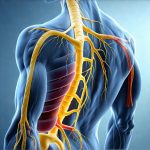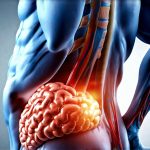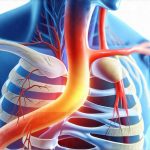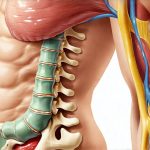Nausea and upper abdominal pain are incredibly common complaints, often dismissed as temporary discomforts arising from something we ate or a fleeting stomach bug. While dietary indiscretions and viral infections certainly play a role, increasingly, healthcare professionals are recognizing the significant impact lifestyle factors – specifically poor posture and prolonged sitting – can have on digestive health and the experience of these symptoms. Many individuals don’t realize how intimately connected their musculoskeletal system is to their gastrointestinal function. The body operates as an integrated unit, and compromising one area inevitably affects others. This article will delve into the often-overlooked relationship between postural habits, sedentary behaviour, and the exacerbation of nausea and upper abdominal discomfort, offering insights into why this occurs and what steps can be taken to mitigate these issues.
It’s important to understand that the digestive system isn’t simply a passive receiver of food; it relies on efficient muscle contractions – peristalsis – to move food along its pathway and extract essential nutrients. The abdominal organs, including the stomach and intestines, are supported by surrounding muscles and rely on adequate space for optimal functioning. When posture is compromised or when we spend excessive periods sitting, this support system gets disrupted. Compressed abdominal cavity reduces the room available for proper organ function and can impede peristalsis, potentially leading to feelings of fullness, bloating, nausea, and pain. This isn’t about a direct “cause-and-effect” relationship in every case, but rather an understanding that these lifestyle factors can significantly contribute to or worsen existing digestive sensitivities and vulnerabilities. Understanding the impact of poor gut health is also crucial for overall well-being.
The Mechanics of Posture and Digestion
The human body is designed for movement, not prolonged static positions. When we adopt poor posture – typically characterized by rounded shoulders, a forward head position, and a slouched back – it creates a cascade of negative effects that directly impact the abdominal region. A slumped posture compresses the abdominal cavity, effectively squeezing the internal organs. This compression hinders proper digestive function in several ways: – It reduces space for the stomach to expand comfortably after eating. – It restricts blood flow to the digestive tract, impacting nutrient absorption and potentially causing discomfort. – It can lead to increased pressure on the diaphragm, affecting breathing mechanics and further hindering abdominal movement. Imagine trying to operate a complex machine within a confined space – that’s what happens when you compress your abdomen through poor posture. Recognizing how dehydration can exacerbate these issues is also important.
Furthermore, prolonged sitting, even with seemingly “good” posture, creates its own set of problems. Sitting deactivates many core muscles essential for supporting the spine and abdominal organs. This lack of muscle engagement leads to weakened postural support over time. A weak core means less stability for the digestive system, making it more vulnerable to compression and dysfunction. The act of sitting itself can also encourage a forward tilt of the pelvis, further contributing to rounded shoulders and a compressed abdomen. It’s not just how you sit but how long you sit that matters; consistent breaks and movement are vital to counteract these effects. Considering sedentary lifestyle impacts on digestion speed can help understand the bigger picture.
Sedentary Lifestyles & Visceral Sensitivity
A sedentary lifestyle isn’t merely about physical inactivity; it also affects the nervous system’s perception of internal signals. The vagus nerve, a crucial component of the gut-brain axis, plays a significant role in regulating digestive function and communicating sensations – including nausea – to the brain. Prolonged sitting and poor posture can disrupt vagal tone, reducing its ability to effectively manage digestive processes and potentially leading to visceral hypersensitivity. This means that individuals become more sensitive to normal digestive activity, perceiving it as pain or discomfort even when there’s no actual underlying pathology. In essence, a sedentary lifestyle can “tune up” the sensitivity of your gut, making you more prone to experiencing nausea and abdominal pain.
This heightened sensitivity is often compounded by stress. Chronic stress, frequently associated with modern sedentary lifestyles, further exacerbates visceral hypersensitivity. When stressed, our bodies enter “fight or flight” mode, diverting blood flow away from the digestive system and prioritizing energy expenditure for immediate survival. This can disrupt digestion and increase the likelihood of experiencing nausea or abdominal pain. The combination of a compressed abdomen, reduced vagal tone, and increased stress creates a perfect storm for digestive distress. It’s crucial to recognize that these factors often interact with each other, amplifying their individual effects. Gut microbiota play a vital role in regulating inflammation and overall health.
Addressing Posture & Movement
Improving posture isn’t about achieving an unattainable “perfect” pose; it’s about cultivating awareness and making small, sustainable changes to your daily habits. Here are some strategies: – Ergonomic Assessment: Evaluate your workstation to ensure proper chair height, monitor placement, and keyboard positioning. Aim for a setup that supports a neutral spine. – Regular Breaks: Set reminders to get up and move every 30-60 minutes. Even short walks or stretches can make a significant difference. – Mindful Posture Checks: Throughout the day, consciously check your posture. Are your shoulders rounded? Is your head forward? Gently adjust yourself back into alignment.
Beyond workstation adjustments, incorporating specific exercises to strengthen core muscles and improve postural support is essential. Exercises like planks, bridges, and bird-dogs help stabilize the spine and abdomen, creating a more resilient foundation for digestive function. Yoga and Pilates are also excellent options as they emphasize core engagement and mindful movement. Remember that consistency is key; even 10-15 minutes of daily exercise can yield substantial benefits over time. Disrupted microbiome can have a significant impact on energy levels and overall health.
The Role of Diaphragmatic Breathing
Diaphragmatic breathing, often referred to as “belly breathing,” is a powerful technique that directly counteracts the negative effects of poor posture and sedentary lifestyles. When we breathe diaphragmatically, we engage the diaphragm – a large muscle located at the base of the lungs – which helps expand the abdominal cavity and massage the internal organs. This gentle massaging action can stimulate peristalsis, improve digestion, and reduce feelings of nausea or bloating.
To practice diaphragmatic breathing: 1. Lie on your back with knees bent and feet flat on the floor. 2. Place one hand on your chest and the other on your abdomen. 3. Inhale deeply through your nose, allowing your abdomen to rise while keeping your chest relatively still. 4. Exhale slowly through your mouth, feeling your abdomen fall. Focus on breathing deeply and rhythmically for several minutes each day. This practice can help restore vagal tone, reduce stress, and promote optimal digestive function. Eating with mindfulness is a complementary practice to diaphragmatic breathing.
Integrating Movement Throughout the Day
Breaking free from a sedentary lifestyle doesn’t require hours at the gym; it’s about integrating movement into your daily routine. Simple changes like taking the stairs instead of the elevator, walking during phone calls, or parking further away from your destination can all contribute to increased physical activity. Consider incorporating active workstations – standing desks or treadmill desks – if feasible.
Furthermore, prioritize activities you genuinely enjoy. Whether it’s dancing, hiking, swimming, or gardening, finding movement that feels pleasurable will make it more sustainable in the long run. The key is to shift your mindset from viewing exercise as a chore to seeing it as an integral part of a healthy and balanced lifestyle. Prioritizing movement isn’t just about physical health; it’s about nurturing your digestive well-being too. Gut health can also be linked to skin conditions, highlighting the interconnectedness of body systems.


















